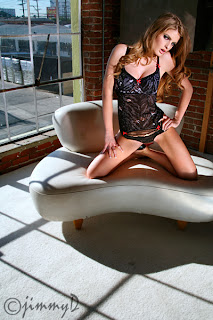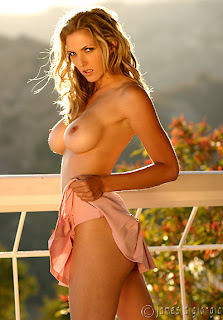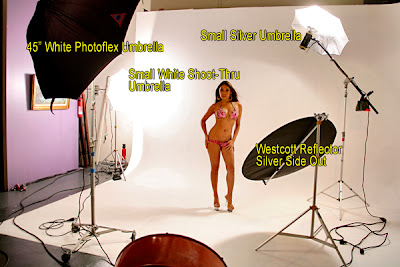
It's refreshing to encounter shooting situations where I get opportunities to venture outside my usual, pretty-girl-shooting, cookie-cutter,
safe zone. This past Thursday was just such a day. Leastwise, my first set in the A.M. went down that way.
I was booked to provide photo coverage for a video shoot at a loft studio in downtown L.A. This means I would shoot the
glamour pretty girl pics (used for the DVD's front cover, advertising, and other applications) as well as the on-set action shots. (The hard-core and soft-core
adult content.)
The loft studio was cool. It was on the second floor of an aging brick building near the Boyle Heights area of Los Angeles. (Not the kind of place you'd want to go out alone for an evening stroll.)
When I arrived, my first
victim girl, Faye, was already in the makeup chair. I asked the MUA, the lovely Dehlia, how long before she'd be ready and was told about 30 minutes. No problem. I can set up in 30 minutes easily.
I decided--since they told me I could shoot pretty much anywhere in the studio as long as I didn't interfere with the video shooting--I'd do my first set next to some windows where the morning light was intensely shining through. Apparently, Faye was going to be the covergirl on the DVD's front cover and the director wanted some pics of her that were a little more on the dramatic side.
The windows frames were casting some really cool shadows on the white-carpeted floor and I thought it would make for some interesting images. I knew I could equal or overpower the sunlight with my strobes but I didn't have much with me to control my lights: No grids, doors, flags,or any of that stuff. (I try to travel as light as I can... which still fills my trunk and back seat with gear.) I didn't want to blow out the shadows and, instead, wanted to light the model separated from the rest of the shooting environment, leaving the rest of the set the way the sun was lighting it. In other words, because of what the images would be used for I needed to brightly
pop the model but in a very directed and controlled way-- isolated from the rest of the image. (i.e., I couldn't shoot her semi-hidden in shadow nor did I want to blow out those shadows.)
The video's gaffer, Joel, and a lighting grip were setting up nearby. "Dude!" I shouted. "You have any HMI's with you?"
"Yeah," he said. "I have a couple of 1200 PARs in the van." (1200 = 1.2K and PAR = Parabolic Aluminized Reflector.) "I was just about to bring them in." he added.
"Cool!" I beamed. "Could I use one?"
Joel agreed and said he'd assist for me if I wanted. I'm rarely one to turn down some offered help.
BTW, for those who aren't familiar with them, HMIs are powerful, daylight-balanced, continuous lighting instruments. The "H" is for
Hg, the symbol for the chemical element, mercury, the M stands for
medium arc, and the "I" is for
iodides. In other words, an HMI is a focusable arc light (focused by using various lenses) producing intense and continuous daylight-balanced light.
The MUA was just putting the finishing touches on Faye as Joel started setting up the HMI where I asked him to put it. For most of the stuff I shoot (on video sets, that is) I usually get about a half-hour with the model. That's 30 minutes from the time the model gets up out of the makeup chair and when I need to click my last exposure. I usually have the lights semi-set where I want them and I start taking meter readings once the model is mine and standing where I need her to be.
Joel had the HMI where I wanted it. He also brought a medium shiny board for some fill. I pulled out my 5-in-1 Westcott reflector and used it, with the silver-side out, for some additional fill. In the image below, Joel is
hitting on engaged in a professional discussion with Faye. You can see the arrangement of the HMI, the shiny board, and the reflector in the pic.

The clock was ticking for my time with Faye and the PM (Production Manager) was already impatiently asking me why I wasn't shooting yet. I started taking meter readings while Joel assisted, focusing the HMI and aiming and diddling with the shiny board and the reflector to get the light where I wanted it as well as the the exposure I was looking for. What made it even more difficult was the fact that, between the shiny board and the HMI, the light on the model was very bright and intense. For almost every capture, I had to count to three and, on "three," the model would open her eyes. I'd then click the shutter and, almost immediately, Faye would close her eyes again.
Everyone that counts (the client, the director, the PM, the model, and Joel and I) were happy with the results. I was especially happy for the opportunity to shoot something outside my usual comfort zone. And, by the end of the day, the world could rest easier: Another porn masterpiece was in the can--with accompanying photo documentation--and I get to stay off the dole for another week or two.
Here's another of Faye. I'm happy to say that anyone familiar with my work would probably not recognize these images--whether they like them or think they suck--as the work of JimmyD, a.k.a. the Pretty Girl Shooter.



































